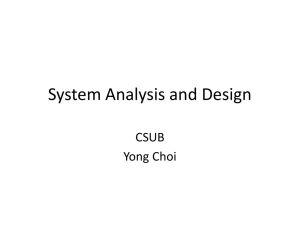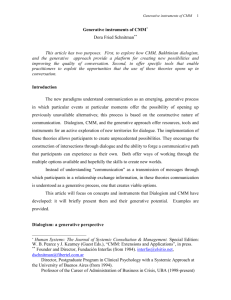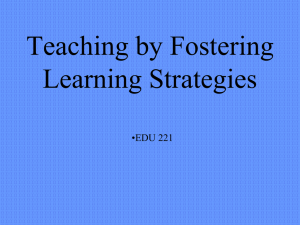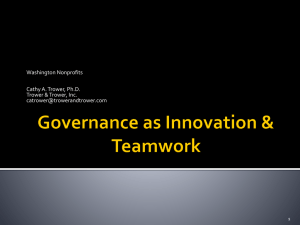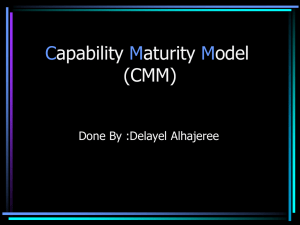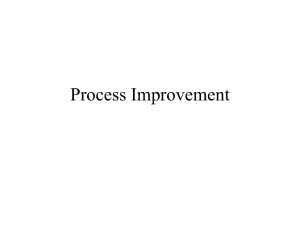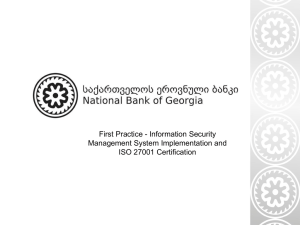CULTURE AND THE THEORY OF THE COORDINATED
advertisement
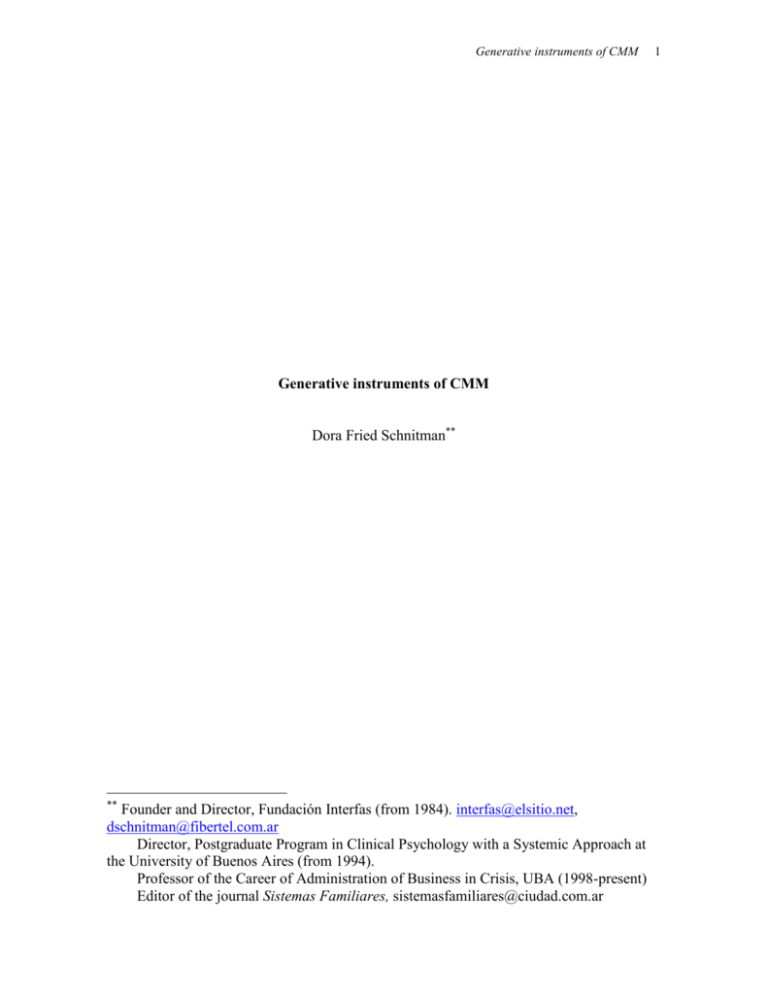
Generative instruments of CMM Generative instruments of CMM Dora Fried Schnitman** ** Founder and Director, Fundación Interfas (from 1984). interfas@elsitio.net, dschnitman@fibertel.com.ar Director, Postgraduate Program in Clinical Psychology with a Systemic Approach at the University of Buenos Aires (from 1994). Professor of the Career of Administration of Business in Crisis, UBA (1998-present) Editor of the journal Sistemas Familiares, sistemasfamiliares@ciudad.com.ar 1 Generative instruments of CMM 2 Generative instruments of CMM This article has two purposes. First, to explore how CMM and Bakhtinian dialogism provide a platform for creating new possibilities and improving the quality of conversation. Second, to offer specific tools that enable practitioners to exploit the opportunities that the use of these theories opens up in conversation. Introduction The new paradigms understand communication as an emerging, generative process in which particular events at particular moments offer the possibility of opening up previously unavailable alternatives; this process is based on the constructive nature of communication. Dialogism and CMM offer resources, tools and instruments for an active exploration of new territories for dialogue. The implementation of these theories allows participants to create unprecedented possibilities. They encourage the construction of intersections through dialogue and the ability to forge a communicative path that participants can experience as their own. Both offer ways of working through the multiple options available and hopefully the skills to create new worlds. Instead of understanding “communication” as a transmission of messages through which participants in a relationship exchange information, in these theories communication is understood as a generative process, one that creates viable options. This article will focus on concepts and instruments that Dialogism and CMM have developed: it will briefly present them and their generative potential. Examples are provided. Dialogism: a generative perspective Today the notion of dialogue is central to a large variety of human sciences; the following is my summary of the work of the Russian linguist Mikhail Bakhtin. The word "dialogue" means to make sense through. For Bakhtin, dialogue is always in process and in progress, incomplete, open, heterogeneous and multiple (Morson and Emerson, 1990). Bakhtin postulates that dialogue entails the construction of a multi-vocal and dynamic unit. Generative instruments of CMM 3 It is in this complex and contradiction-riddled unit that social processes occur. Each dialogue is unique; it takes place in a specific temporal-spatial context –chronotope– and it is only possible to enter its sphere of meaning through understanding the uniqueness of the context. The Bakhtinian perspective on dialogue centers on how plots, biography, unity, innovation and the creative process emerge. It highlights the inter-relatedness of self and Other in language and being. Each dialogue has diverse voices and intonations. Bakhtin views communication as creating our sense of identity and reality. Different ways of talking evoke different understandings and orderings of social life. Furthermore, the process projects into the future: subjects in dialogue propose possible futures, which may or may not be compatible. Bakhtin stresses the inner process of dialogue and its capacity to create meaning. According to Bakhtin, when you speak to another person, you include him/her in your utterance. Likewise, the listener doesn't simply decode an utterance, but also captures to whom it is directed; s/he relates it to his/her interests and suppositions, as well as imagining how the utterance responds to future utterances. The listener must also go through the complex process of preparing an answer to what has been said. When a response is formulated, the listener knows that it is not the only one possible. Bakhtin suggests that interlocutors are not necessarily another physical person, but might also be oneself; indeed, it might even be the product of another dialogue, a certain topic or anything else. Each utterance in a dialogue exists in a net of dialogues, which both facilitates and limits its possibilities. An utterance not only resonates with what has been said and will be said, it also produces something new and unique: a contribution to what will happen next. This contribution lies in how, where and when something is said. In summary, dialogism offers practitioners a generative resource: the ability to understand the complexity of dialogue and the singular and inner processes through which it is constructed as well as its contexts. This complexity is the starting point for the construction of new discourses and storylines. Each of these dialogues is unique, and the Generative instruments of CMM 4 tools offered by Dialogism are useful for construction in action, rather than providing an abstract ideal. A practitioner alert to this diversity can intelligently choose which of the possible courses in dialogues can best help the clients, and explore it with them. The content of the chosen storyline is not the only consideration, however. Voice and intonation are also key components as well the circuits within and between dialogues we just mentioned. Coordinated management of meaning (CMM) Developed by Pearce and associates, CMM’s approach to communication lies in the Wittgenstein tradition of speech acts and language games. Wittgenstein suggests that we participate in multiple intertwined language games. These games have the power to shape the episodes where they occur. CMM is part of the scholarly legacy of those who look at communication as performative (that is, what people do by what they say) rather than referential (that is, what people are talking about). Their first question is what people are doing when they communicate, and their second is why they communicate in a certain manner. According to CMM theorists, the answer to these questions does not lie in our cognitive states or personalities, but rather in the performative nature of communication itself; that is to say, the communicative act is understood to have its own characteristics and does not only refer to other things (Pearce, 1989, 1994, 2001, 2002). It is what is done by what is said and how it is that sets up the language game between participants. When we work from a generative perspective we explore the diversity of existing language games and try to go beyond their limits. On the one hand, we are situated in the current dialogue and, on the other, we facilitate new realities and forms of life. We wish to stress that generativity and ethics are connected. Generativity is opening up new spaces in dialogue. Ethics is a constant exercise of reflection on that generative process: that is to say, ethics involves what is said and what happens because of what is said. Both of these processes are key to the generative process in therapy, consultation and other practices. Generative instruments of CMM 5 By examining the limits of our language games, we explore and expand the choices available in these games, as well as how to maintain and expand them. This process allows us to move into new territories and forms of living. Indeed, we are constantly engaged in this process when we express ourselves and respond to others, when we respond to their expressions and when we organize our discourse or narrate our stories (Andersen and Rivera, 2001). CMM tools for a generative perspective CMM developed a number of models, concepts and instruments tied to the communication event itself which are geared toward improving conversations; they facilitate the emergence of new resources in communication and forms of living. This section presents some of these notions, tools and instruments. Episodes CMM utilizes the concept of episode to refer to the particular punctuation actors give events of their life. To do this they divide the life flow into meaningful units or chunks. Episodes are units that have a plot, a coherent narrative line (examples of micro episodes are having a discussion, working on a project, there are also macro episodes which could be partial aspects of life narratives). Participants may coincide or not in their interpretations and punctuation and be open or not to alternatives. Questions to explore their flexibility might include: How others or we might have acted? How are the events ordered for others? What are their perspectives? How might I act next time? Episodes entail –to a greater or lesser extent– an articulated matrix of values, assumptions, morals, and sense of appropriate actions. An episode could be highly structured within any social unit –a family, organization, culture, etc.– one with rituals, roles, and prescribed behaviors or not. Each episode contains a vision of self, others and relationships. A generative perspective is interested in their potential to create emergent possibilities and/or their openness to be transformed. We can use episodes to explore and recognize how each person’s punctuation and perspective is singular or shared with others. Generative instruments of CMM 6 Questions-guide that participants can utilize for this exploration: What aspects of the episode are you considering? Are the participants considering the same aspects or different ones? In what order will they be considered? What other elements might to be considered? What unnecessary elements distract us from the main issue in this particular situation? What elements could be changed or added to favor the conversation’s advancement? Could this episode be transformed? How? Daisy model The daisy model is another CMM tool for exploring the richness of a communication situation. This model is designed to remind us of the multiple conversations that are occurring at each moment, and often between more than two people. As a practitioner, you might use this model by putting a specific conversation in the middle of a circle of dialogues (petals) and begin to trace out some of the other conversations to which it is connected, even with participants who are not physically present. If one looks at the sequence of utterances in the conversation, the question would be: to what extent is the current exchange a response to this or other conversations, be they immediate or distant. What is the project of each utterance in a specific dialogue or a sequence of dialogues? What was the intended purpose of the utterance? Who is the intended audience for certain remarks? How many people are being addressed? How do each interplay with the others? What conversations as contexts of meanings need to be distinguished from others and which ones linked? As you focus on each of these conversations, the meaning of what is said differs, as does the logical force that explains why interlocutors say what they do. From a generative perspective, the daisy model suggests a variety of constructive/deconstructive places for intervention. Practitioners learn a series of skills: to deconstruct and weave between dialogues; to recognize the different implicit meanings operating in what is said or heard; to clarify why certain comments can generate unexpected effects; to recognize what values are at stake in different conversations; to Generative instruments of CMM 7 recognize which conversation should be privileged at each moment; to generate alternatives by shifting the position of the conversations (petals) or by connecting them. Practitioners can use the following questions to implement this model: From which conversation (petal) is one speaking and listening? What other conversations (petals) could provide new meanings and possibilities? Would it be possible to add new conversations (petals)? What values do not have meaning for the current conversation? What values that are in fact meaningful for the current conversation are not present? How do conversations different conversations interplay, does their interaction generate dilemmas, paradoxes or opportunities for the novel? Do they merge or not? Hierarchy Model or interconnected contexts This model starts with the familiar notion that meaning is dependent on the context in which it occurs, but adds the idea that communication acts are always in multiple contexts. These contexts might include concepts of self, relationships, episodes, life scripts, cultures, etc. These multiple contexts imply multiple meanings. We can use this model to elaborate multiple meanings and stories, evaluate how the various stories can be interconnected and recognize which context is being privileged and why. Practitioners can use the following questions to implement this model: In what context is this situation located? What would this situation meaning be like in another context? What conditions favor this situation meaning/s? What context offers better conditions for this situation? Is it possible to move this situation into other more favorable contexts? It is worth mentioning that both the daisy and the interconnected contexts models see diversity as an opportunity for creating new means, transforming relationships between context and meaning, linking conversations, or bringing together existing meaning in order to create novel possibilities. Logical Force Generative instruments of CMM 8 We live within networks of obligations and duties. In specific situations, when others act in certain ways, we feel that we “must” (or “need to” or “can” or “mustn’t”) act in a certain way. This sense of obligation varies in intensity. When it is weak, we can choose our course of action with greater freedom; other times, the “logical force” is overwhelming and we feel we have no choice. “Pre-figurative force” (what others have just done) exercises a framing influence, as do “contextual force” (the preexisting relevant situations or culture), “practical force” (how we want others to respond), “implicative or reflexive force” (the effect we wish our actions to have in the context in which they occur) move in the direction of creating. We can use the logical force model to recognize and to order the different forces that influence decisions and actions; to explore other possible ways to confront the situation; to assess the implications of the new possibilities. People act in relation to contextual and pre figurative forces (that is, what the existing contexts are or where and what the other person has done in those contexts) or in relation to practical or implicative forces (that is, what contexts we want to call into being or what we want the other person to do or not do). Sometimes people feel that they ought to act in response to previous contexts or in response to what others have done no matter how unpleasant their actions might be or how destructive the consequences are. In CMM’s technical language, if the strongest logical forces are the practical and/or the implicative, people might be more inclined to explore new ways of thinking and being. Their dynamic is of particular interest for a generative perspective. Practitioners can use the following questions to implement this model for reconsidering logical forces: Why is it necessary to speak or act in a certain way? What are the discrepancies between the operating forces in a specific situation? What would (I) like to say or do to change a situation? Who will benefit or be hurt? What circumstances must change to enable another way of speaking or acting? What possibilities that have not yet been considered could change these circumstances? Generative instruments of CMM 9 LUUUTT model Another CMM model, the LUUUTT (an acronym of its components) involves lived stories, untold stories, unheard stories, unknown stories, stories told, and storytelling model. It also helps practitioners enrich specific instances of communication. If we take the role of a practitioner seeking to enrich the conversation through the LUUUTT model, we might begin with stories told and the manner of storytelling. Stories can be told in many different ways and life is so rich that different storylines might be available. There are stories told by some participants but not heard by others, stories known by some but not told in such a way that others can hear them and unknown stories. Tellers might or might not have a readiness to adapt to other persons’ stories or cultures. To varying degrees, participants are willing or unwilling to consider alternative perspectives. When there is no possibility of opening up the stories, they are told in an accusatory manner (the voice is loud, the utterance dogmatic, the speaker unwilling to express doubts, reservations, or uncertainties; the communication does not have nuances and “unheard stories” abound). The logical forces tend to be contextual and prefigurative, references to the past abound. When confronted with such speech, we can use LUUUTT model to shift the course of the conversation by asking the participants to clarify what they are saying, utilizing circular or reflexive questions to open them up; we can follow up with questions about uncertainties, perceptions of the other, personal experiences, explore convergences, shift into the future, or other conversational resources. By doing this, practitioner slow things down, hope to change the conversation’s logical force, relieve the participants of the obligation to respond immediately to one another, invite hearing previously unheard stories and telling previously untold stories, and provide a model of listening to and questioning rather than denouncing the other. All of this is an attempt to change the mode of storytelling to one that has more opportunities for good things to happen. Practitioners learn a series of skills: to recognize what stories or parts of stories are relevant to the situation; to consider other possible ways of narrating the story/stories; to assess what other features could be important for the story and if they form part of lived Generative instruments of CMM 10 stories, untold stories or unheard stories; to consider what new possibilities could be offered by stories that might be incorporated. Practitioners can use the following questions to implement this model: What happened, or troubled you or what did you know and not say at that moment? [untold stories] What else might have happened to make things turn out differently? [stories to be told] Can you remember what s/he said/ did in that situation? [stories heard] How else could the story be told to incorporate the information that you did not have or remember? [new stories] What new possibilities open up as a result of this new information? [consequences of retelling] CMM’s serpentine model As CMM considers speech performative, practitioners explore what kind of identities, episodes, relationships and cultures are being constructed by patterns of speech when people interact with each other. To unravel these patterns, a serpentine model was developed. Each act is done with, to, for, or against someone in time sequences. Each of these relationships can be deconstructed and reconstructed. CMM’s serpentine model is designed to call attention to this process and utilize it for furthering the understanding of the back and forth of communication. Like Bakhtinian dialogism, the serpentine model focuses on communication as a process, in motion, but this school offers a model to map communication. When CMM practitioners or researchers use this model, they begin by describing the communicative acts in the sequence in which they have occurred; they may even physically lay them out from left to right on a large sheet of paper. The second step is to map out the various contexts and positions from which communicators speak and respond to each other. A serpentine movement is produced in moving through this communication chain. This serpentine path displays the interaction between two or more persons in time. Two things happen as you follow this to- and fro- movement. First, the logical force of the interaction (the sense of what you “ought” to do) shifts from intrapersonal to interpersonal. Generative instruments of CMM 11 That is, the reason why a person in a conversation says or does what s/he says or does is not only a function of her embedded contexts but also what the other person has done and said in other conversations, and how that meshes with her own meanings. CMM analysis of a communicational act wants to know what happened before the act in question (perhaps immediately before or perhaps a long time ago) and what might happen next. Practitioners learn a series of skills: how to pay attention to the back and forth of social interaction; how to understand which collaborative actions open up options in communication and which ones don’t; how to recognize which new actions could generate other possibilities, change certain episodes favorably. Practitioners can use the following questions to implement this model: What does what s/he has said or done mean to you? It is something just said or it a related to other conversation? Would it mean something different to you if the other participants had done something differently? What might they have done? Would you have acted as you did had you known that the other/s were going to interpret your action as they did? What might you have done? How should you set up the situation so that others do not feel affected? What new proposals could you give or receive to generate other possibilities? Generative approach’s contribution to conversation The generative approach works with the relationship between communication and learning. It approaches communication as a web of nodes and thematic links. It fosters the ability to weave meanings and to utilize reflexive learning to question the supposed limits of the webs and to empower subjects. The approach not only considers the specific speech acts and coordination that have occurred in a relationship. It also contemplates the virtual spaces of relationships, their intangible ensembles, their connections with the environments (Fried Schnitman, 1996, 1998, in press; Fried Schnitman and Schnitman, 2000a-b, 2002). To expand the relational web, this approach uses mediating and generative devises. These include mediating between existing meanings, being alert to new meanings that arise Generative instruments of CMM 12 spontaneously in a discourse and creating new meanings oneself. In addition, reflexive learning (asking how an action or utterance was different). Generative dialogues and circuits We have posed that the generative perspective privileges the emerging opportunities that are unique to each process and facilitates the development of skills to recognize these opportunities. This perspective, which is interested in enriching conversations, incorporates the participants as researchers into the situation they are seeking to transform. It views them as people who can produce unprecedented possibilities in a dialogue, that is, as proactive subject-agents who utilize their own reflections to increase comprehension and improve action. In this sense, those who participate in a generative process –therapists and clients, mediators and mediated, consultants and consulting parties– become the creative authors of each process. The perspective looks towards the future and what needs to change to construct it to the liking of participants. Reflection brings to view novel options and choices that can, in turn, be the object of new reflections, thus forming a generative spiral. If the process is oriented towards problem solving, the solution can be found by identifying what is not done well, thus transforming the problem into a possibility for change or recycling existing possibilities. The transformation of a problem into a possibility to be worked on brings to mind Escher, in whose production an object is progressively transformed by alterations of the edges. These alterations are almost imperceptible at first, but through repetition they become evident (transformative). We can work using another model derived from the arts: surrealism. Like Dalí, we can subvert previous or traditional relations between meanings and contexts, re-formulate, re-frame, re-signify, redefine, and so on. If the process is oriented towards discovering resources, on the other hand, the approach privileges doing more of what does work. This involves increasing the appreciation of what exists. An appreciation of the existent provides a starting point for effecting modifications; we begin to imagine ways to expand on this positive dimension. Generative instruments of CMM 13 Dialogic construction of alternatives: dialogue, nodes, links The generative perspective considers creation of new possibilities one of its objectives and tasks. It proceeds by means of the exploration of the thematic nodes and links that arise from dialogue or between dialogues. How are nodes and links organized in dialogue? In general, through an episode containing topics or comments with generative possibilities. Usually, it is something that the participants use in different moments to weave together practices, experiences, feelings and extant or novel descriptions. At some moment, a node acts as a catalyst, illuminating the capacity to effect change, and participants must seize the moment and explore the possibilities opened up at this crucial juncture. Practitioners can use the following questions to implement this model: Questions that identify and describe novel possibilities: What novel possibilities have appeared? What does each of them contribute and how? What is the contribution of the novel and what possibilities of action does it offer? Could these possibilities form a part of your daily family/community/work life? What changes would they produce? Questions that identify and describe possible roads and emerging visions How do the new possibilities respond –or how could they respond– to the topics in question? What changes would the new possibilities produce? How could you and other participants construct something new together? What future would you like to construct? How could personal and shared interests expand in this vision of the future? In the course of this process, what awakens your curiosity and invites you to deepen exploration? What are your questions, fears and uncertainties? Generative instruments of CMM 14 Inquiries that facilitate recognition of the other and emerging identities What did you hear the other say? How did you hear the other felt? Did s/he propose anything you had not considered or heard before? What did you notice as different in the other with respect to previous positions? In what ways did you feel listened to? What novel situations do you find yourself in? Comments that increase the communal and collaborative conscience How would the new possibilities and mutual recognition benefit the parties? What other persons would benefit and how? In what new ways would you be able to talk among yourselves and with others? In what specific ways could each participant become involved in the construction of new possibilities? What could make it easier to change your relationship? Closing and opening words Generative processes have the potential to go beyond the limits of what we say, think or do and thus expand forms of life. We can find new descriptions to solve conflicts, transform relations and help persons cope with difficult or problematic circumstances. We can build bridges in the midst of conflict, construct possibilities for coordination and promote novel social formations. Rising to the challenge of turning this vision into a practical reality restores the view of persons as subject-agents who can rest on their capacity to learn and innovate in order to handle the very diverse problems that life presents to them. CMM provide resources to do just this. From an episode into a paradigmatic shift Lynn came for a consultation in the spring of 1998 because she was pregnant and wanted to speak with a professional about whether or not to keep the baby [episode which is the center of the conversation]. She had spoken at length with her family, her partner Generative instruments of CMM 15 and his family [other petals in the conversation]. Her mother called me to request that I see Lynn to help her through the decision making process [episode being helped/helper in the process of making decision]. Lynn did not know what to do. She felt pressure from her partner, and both families who wanted her to keep the baby. However, she felt that neither she as a person nor the couple was ready to have a baby [hierarchy model of meaning, relational, script and self]. This pregnancy was an unexpected event in their lives. Lynn was the primary breadwinner through her work as a teacher. The partner had some income of his own, and his family was helping out while he was finishing film school [stories to be spoken about]. The families were committed to supporting them, her sisters who were mothers of large families encouraged them, but the couple did not have the resources for an independent economic life. Although Lynn was very fond of her partner’s family at times, she wanted to be more independent and knew that their involvement would clearly increase if they had the baby [untold story]. We had some interviews to deal with this critical situation. Specifically, we went over her options [she felt a need to review her priorities and re-tell stories about herself and her relationships, to revise the hierarchy of conversations that were meaningful for the decision], with whom she could and with whom she could not have conversations about the issue, her own feelings about having the baby and how to differentiate them from those of others, her priorities in life. Basically, she needed to revise her stories about herself and set up her priorities to be able to make her decision. To use Lynn’s words, this process developed into a “paradigmatic event” for her, one which marked a shift in how she constructed her life: she learned how to recognize her needs and distinguish them from those of others [the process of making a decision – practical force– turn into a significant shift in many areas of her life –implicative force]. For the first time, she had the experience of carefully and actively positioning herself in the context of a very meaningful life decision, recognizing her own style, needs and desires, as well as those of the others involved, approaching the relevant issues, finding a pattern for decision making, and developing a sense of timing; she became aware of how she was talking and listening to herself and others and, as a result, was gradually able to change these engagements. Generative instruments of CMM 16 Lynn and her partner decided that the final decision was hers, and she decided not to keep the baby. As the example suggests there was room for conflict and paradoxes between participants, their desires, interpretations and preferred decisions including the ones Lynn herself had, they where dealt with, turned into evolutionary dilemmas and life choices. What she calls paradigmatic shift becomes a contextual and pre figurative force for the treatment consultation, which continued afterwards. Bibliographical references Andersen, T. and Rivera, S. (2001). Clínica y ética aplicadas: en las fronteras de lo que podemos decir y pensar, Sistemas Familiares, 17 (3), 65-74. Fried Schnitman, D. (1996). Between the extant and the possible, Journal of Constructivist Psychology, 9 (4), 263-282. Fried Schnitman, D. (1998). Navigating in a circle of dialogues, Human Systems: The Journal of Systemic Consultation & Management, 9 (1), 21-32. Fried Schnitman, D. (in press). Generative instruments for moving beyond conflict in organizations”. In D.M. Hosking and S. McNamee (eds.), Social Constructionist Alternatives to 'Organizational Behaviour'. To be published by John Benjamins Publishing Co. Fried Schnitman, D. and Schnitman, J (2000a). La resolución alternativa de conflictos: un enfoque generativo (Alternatives in conflict resolution: A generative approach). In D. Fried Schnitman (ed.), Nuevos Paradigmas en la Resolución de Conflictos: Perspectivas y Prácticas (New Paradigms in Conflicts Resolution: Perspectives and Practices), Editorial Granica, Buenos Aires, 133-158. Fried Schnitman, D. and Schnitman, J. (2000b). Contextos, instrumentos y estrategias generativas” (Contexts, instruments and generative strategies). In D. Fried Schnitman and J. Schnitman (eds.), Resolución de Conflictos. Nuevos Diseños, Nuevos Contextos (Conflict Resolution. New designs, New contexts), Editorial Granica, Buenos Aires, 331-362. Fried Schnitman, D. and Schnitman, J. (eds.) (2002). New Paradigms, Culture and Subjectivity, Hampton Press, New Jersey. Morson, G.S. and Emerson, C. (1990). Mikhail Bakhtin. Creation of a Prosaics, Stanford University Press, Stanford. Pearce, W.B. (1989). Communication and the Human Condition, Southern Illinois University Press, Carbondale-Edwasville. Generative instruments of CMM 17 Pearce, W.B. (1994). Interpersonal Communication: Making Social Worlds, Harper Collins, New York. Pearce, W.B. (2001). Introducción a la teoría del Manejo Coordinado del Significado, Sistemas Familiares, 17 (2), 5-16. Pearce, W.B. (2002). New models and communication: Shifts from theory to praxis, from objectivism to social constructionism, and from representation to reflexivity. In D. Fried Schnitman and J. Schnitman (eds.), New Paradigms, Culture and Subjectivity, Hampton Press, New Jersey, 197-208.
